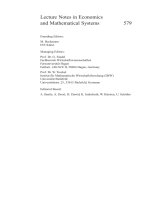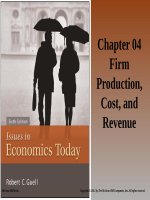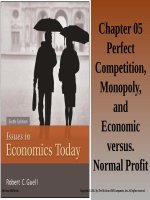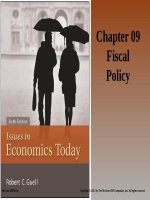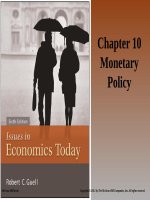Lecture Issues in economics today - Chapter 39
Bạn đang xem bản rút gọn của tài liệu. Xem và tải ngay bản đầy đủ của tài liệu tại đây (247.93 KB, 17 trang )
Chapter 39
Energy Prices
McGrawHill/Irwin
© 2002 The McGrawHill Companies, Inc., All Rights Reserved.
Chapter Outline
•
•
•
•
•
HISTORICAL VIEW
OPEC
WHY PRICES CHANGE SO FAST
WHAT WILL THE FUTURE HOLD
Electricity Prices
McGrawHill/Irwin
© 2002 The McGrawHill Companies, Inc., All Rights Reserved.
Real Oil and Ga
per gallon (1 barrel=42
2.5
2
$
1.5
1
0.5
0
1973
1975
1977
1979
1981
1983
1985
1987
1989
1991
1993
1995
1997
1999
year
Real Gas Price
Real Domestic
RealCrude
Import C
McGrawHill/Irwin
© 2002 The McGrawHill Companies, Inc., All Rights Reserved.
Historical Events Relating to
Oil and Gas Prices
• 1972 Arab-Israeli War
– US support for Israel prompted an embargo by Arab oil
producers against the US and Europe. This led to a
significant increase in crude oil prices.
• 1979 Iranian Revolution
– Iran’s Islamic revolution led to instability in the Persian Gulf.
This led to a significant increase in crude oil prices.
• 1980’s
– Rapid increases in profits led to significant discoveries of oil
in Mexico and the North Sea
• 1980-1988 Iran-Iraq War
– The war led to increased production by both parties as each
needed to fund their war effort. This caused a precipitous fall
in crude oil prices.
McGrawHill/Irwin
© 2002 The McGrawHill Companies, Inc., All Rights Reserved.
World Oil Reserves
Group
Billions of Barrels Percentage of
in Reserve
World Reserves
Persian Gulf
664
63%
Non-Persian Gulf
OPEC
134
13%
Rest of the World
238
24%
McGrawHill/Irwin
© 2002 The McGrawHill Companies, Inc., All Rights Reserved.
OPEC
• The Organization of Petroleum
Exporting Countries (OPEC)
– Algeria, Indonesia, Iran, Iraq, Kuwait, Libya, Nigeria, Qatar,
Saudi Arabia, United Arab Emirates, and Venezuela
• OPEC began as a cartel.
– A cartel is an organization of individual
competitors that join to form as a single
monopolist.
McGrawHill/Irwin
© 2002 The McGrawHill Companies, Inc., All Rights Reserved.
th o u s a n d b a r e ls a d
Was OPEC a Cartel?
Oil Production
World, Non-OPEC and
70000
60000
World
50000
40000
Non-Op
30000
20000
Opec
10000
1970197519801985199019952000
Year
OPEC production has always been a significant part of the oil market
but it has never reached the level of monopoly. The cartel model is still
useful because it has been a dominant player.
McGrawHill/Irwin
© 2002 The McGrawHill Companies, Inc., All Rights Reserved.
The Cartel Model
Market for Oil
P
P
One Country’s Oil
MC
S=MC
ATC
Profit
Profit
MR’
Pcartel
PPC
MR
D
Qcartel
McGrawHill/Irwin
MR
QPC
Q
Qquota
QPC Qcheat Q
© 2002 The McGrawHill Companies, Inc., All Rights Reserved.
Why Oil and Gas Prices
Change So Fast
• Because expected price is a determinant of
supply and demand a world event that causes
people to expect a price increase will
– Increase current demand (as middlemen and
consumers try to buy as much as possible)
– Decrease current supply (as middlemen and gas
stations try to hold onto their current stocks)
• This causes an immediate increase in prices.
McGrawHill/Irwin
© 2002 The McGrawHill Companies, Inc., All Rights Reserved.
Electricity
• Residential electric power tends to be
sold by a regulated monopoly.
• It has been a monopoly because of
significant barriers to entry.
• It has been regulated because prices
would be much higher than is socially
optimal.
McGrawHill/Irwin
© 2002 The McGrawHill Companies, Inc., All Rights Reserved.
Types of Monopolies
• Simple Monopoly: a monopoly in which
marginal costs of production are rising.
• Natural Monopoly: a monopoly in which
marginal costs of production are falling.
McGrawHill/Irwin
© 2002 The McGrawHill Companies, Inc., All Rights Reserved.
Monopoly in the Market for
Residential Electricity
• The market for residential electricity is likely
to be a natural monopoly for nuclear power
because of the very high fixed costs
(transmission lines and the power plant and
diminishing marginal costs.)
• The market may be characterized as a simple
monopoly or natural monopoly for coal or gas
generated electricity.
McGrawHill/Irwin
© 2002 The McGrawHill Companies, Inc., All Rights Reserved.
An Unregulated Simple Monopoly
MCMonopoly
P
Pmonopoly
MR
Qmonopoly
McGrawHill/Irwin
D
Q
© 2002 The McGrawHill Companies, Inc., All Rights Reserved.
An Unregulated Natural Monopoly
P
Pmonopoly
D
MR
Qmonopoly
McGrawHill/Irwin
ATC
MCMonopoly
Q
© 2002 The McGrawHill Companies, Inc., All Rights Reserved.
An Regulated Simple Monopoly
MCMonopoly
P
Pmonopoly
Pregulated
MR
Qmonopoly Qregulated
McGrawHill/Irwin
D
Q
© 2002 The McGrawHill Companies, Inc., All Rights Reserved.
An Regulated Natural Monopoly
P
Pmonopoly
D
Pregulated
MR
Qmonopoly
McGrawHill/Irwin
Qregulated
ATC
MCMonopoly
Q
© 2002 The McGrawHill Companies, Inc., All Rights Reserved.
The California Experience
• California produces electricity with natural
gas.
• California “deregulated” by
– Having its utilities sell their productive capacity to a variety of
competitive producing firms
– Having them buy electricity from these producers
– Letting the market price for wholesale electricity float.
– Continuing to fix residential electricity prices.
• Natural gas prices increased dramatically
• The utilities could not buy the power because
they were selling it at regulated prices that
were lower that the deregulated prices at
which they were buying it.
McGrawHill/Irwin
© 2002 The McGrawHill Companies, Inc., All Rights Reserved.
